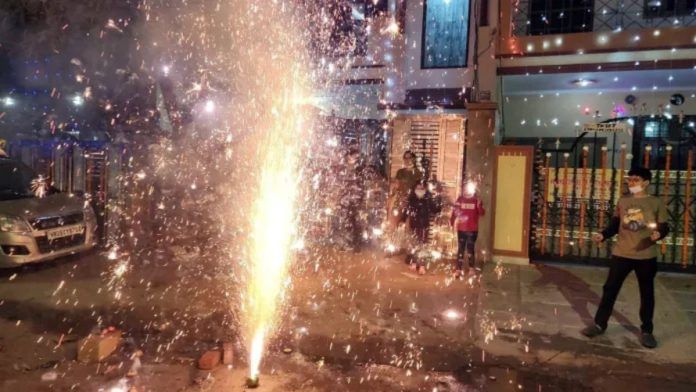The Supreme Court’s Wednesday order allowing green crackers in Delhi was seen by some as a throwback, and others as a setback. After five years of a complete ban on the sale and manufacturing of any firecrackers in the city, the CJI BR Gavai-led bench allowed green firecrackers to be sold and burst from 18 to 21 October.
After hearing the pleas by the Union government, the Delhi government, and manufacturers of firecrackers, the top court decided to maintain a “balance” between festive spirit and health concerns. Allowing for NEERI-certified green crackers, the court said that they could only be burst at specific timings during the day and night, and asked the state authorities to strictly monitor the entry of certified crackers inside the city.
“It is a simple concept—you burn something, it will emit gases. That is certain, whether it’s mainstream crackers, green crackers or anything else,” said Mohan George, consultant for Clean Air and Sustainable Mobility at Centre for Science and Environment. “With green crackers, emissions reduce by 30 per cent, but it also depends on how many of them you burn and if the weather favours you.”
In a city that regularly tops the list of the most polluted cities in the world, even green crackers raise red flags for long-term pollution effects. The Supreme Court’s decision has added back a new wrinkle to Delhi’s pollution debate. One that harkens back to the 2015 Arjun Gopal case, where three toddlers fought for their right to breathe clean air.
Wednesday’s decision has been welcomed by the BJP, which celebrates its first Diwali in the capital after 27 years. In the years when it sat out of power, the party constantly targeted the AAP government for not handling the pollution crisis properly. Now, it is their headache, with the added burden of green crackers. And that is why the Supreme Court’s decision on green crackers is ThePrint’s Newsmaker of the Week.
Also read: Delhi’s smog is back. Here’s how GRAP kicks in to control it
What the science says
Green crackers are named so because they are made using less toxic substances and smaller shell sizes as compared to conventional crackers. While conventional crackers use barium and sulphur, which are known not to burn completely and release harmful gases, green crackers developed by CSIR-NEERI use other metals like aluminium, magnesium-aluminium alloys and iron oxide to create the same effect as firecrackers with lower pollution.
According to CSIR-NEERI’s study, green crackers produce 30 per cent less emissions than normal firecrackers. The main reduction is in PM2.5, sulphur dioxide and carbon dioxide.
However, a study by IIT Delhi scientists in 202 found that green crackers actually release more ultrafine particles, i.e. smaller than 100 nanometers (PM1), than conventional crackers. These particles are smaller than both PM2.5 and PM10, and can even enter the bloodstream. Added to this, environmentalists are concerned that despite the 30 per cent reduction in emissions, the legal allowance of firecrackers will encourage citizens to burst more.
“During Diwali, PM2.5 levels typically rise by over 1,000 per cent above WHO limits. In that context, a 30 per cent reduction is statistically meaningless,” said Bhavreen Kandhari, an environmentalist based in Delhi. “Once the boundary layer drops and the air traps pollutants, even limited cracker use can tip the city back into the ‘severe’ category for days.”
Also read: This Diwali is the first pollution test for Delhi CM Rekha Gupta
Air pollution and Diwali
This is not Delhi’s first tryst with green firecrackers—back in 2018, the Supreme Court had banned conventional firecrackers for the first time and allowed only certain green crackers that are low in emissions. Two years later, both the National Green Tribunal and Delhi’s AAP government banned all firecrackers in Delhi around Diwali, seeing the worsening air quality.
The AAP government became more stringent with firecracker bans, even enforcing jail time for violators in 2022. While the AAP’s message remained focused on preventing air pollution, with then CM Arvind Kejriwal urging citizens to celebrate Diwali with lights and diyas, the BJP was not convinced. Even in 2022, BJP leader Kapil Mishra said banning crackers in Delhi hurt the ‘sentiments’ of Hindus, and that it wasn’t the solution to Delhi’s air pollution crisis.
The order to ban all crackers back in 2020 was brought on by multiple reasons, including the lack of monitoring and the inability to enforce the ‘green-crackers-only’ rules. Even in the Wednesday order, the SC bench made a note to instruct the authorities to ensure strict patrolling, no sale of firecrackers through e-commerce, and sticking to the 10 pm crackers-burning deadline. But experts question whether we have the capacity to ensure monitoring is better this time around.
“The enforcement of green crackers has failed every test—practical, legal, and scientific,” said Kandhari. “Without digital traceability, real-time testing or modernised laws, certification is symbolic, not substantive.”
Another concern brought up by George is that of the certification itself and its validity.
“Visually, there is no difference between green crackers and normal crackers. It’s not like the police or any agency will be able to tell if they find it on the road,” he said. “You need to send the product to NEERI or PESO in Nagpur to check whether the certification is authentic, which takes time.”
After years of claiming that crackers in Diwali had little to do with Delhi’s pollution problem and that it was the AAP government’s fault for being unable to curb pollution, the BJP is now facing its own Diwali litmus test, and experts seem skeptical.
Even with favourable weather conditions, a longer monsoon season, and fewer stubble fires in Punjab, Delhi’s air quality is touching 300 before Diwali. As the temperature dips and dissipating particulate matter becomes even more difficult due to the fog, the Supreme Court’s green crackers order might have just sealed Delhi’s smoggy fate for the year.
Views are personal.
(Edited by Theres Sudeep)






